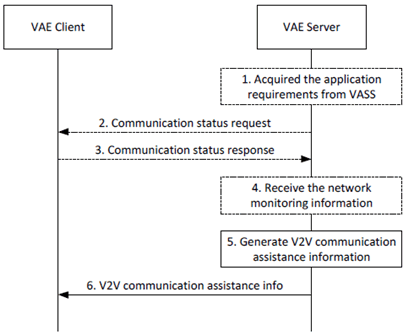Content for TS 23.286 Word version: 18.5.0
0…
4…
6…
7…
9…
9.2…
9.3…
9.4…
9.5…
9.6…
9.7…
9.8…
9.9…
9.10…
9.11…
9.12…
9.13…
9.14…
9.15…
9.16…
9.17…
9.18
9.19…
9.20…
9.21…
9.22…
10…
10.2.8…
A
B…
C…
D…
9.8 Switching modes of operations for V2V communications
9.8.1 General
9.8.2 Information flows
9.8.2.1 Communication status request
9.8.2.2 Communication status response
9.8.2.3 V2V communication assistance info
9.8.3 Assistance for V2V communication mode switching
9.8.3.1 General
9.8.3.2 Procedure
...
...
9.8 Switching modes of operations for V2V communications p. 50
9.8.1 General |R17| p. 50
The V2X services need to support different modes of operation for V2V (PC5 and Uu) communications. The V2X UE makes the decision to switch between different modes of operation for V2V communications considering the V2V service KPIs as specified in TS 22.186. The V2X application layer may provide the network monitoring information or recommendation for the communication mode to assist the V2X UE in making the switching decision for the operation modes selection.
The V2X UE determines switching of the mode of operation for V2V sessions based on several factors including the received network monitoring information as specified in subclause 9.7 and the PC5 communication quality information and assistance information received from the VAE server. The V2X UE switches the mode of operation and engages in either direct (PC5) or indirect (Uu) session as specified in subclause 23.14 of TS 36.300.
9.8.2 Information flows |R17| p. 51
9.8.2.1 Communication status request p. 51
Table 9.8.2.1-1 describes the information flow of communication status request from the VAE server to the VAE client.
| Information element | Status | Description |
|---|---|---|
| V2X UE ID | M | Identity of the V2X UE requested for communication status |
| V2X service ID | O | Identity of the V2X service being requested |
9.8.2.2 Communication status response p. 51
Table 9.8.2.2-1 describes the information flow of communication status response from the VAE client to the VAE server.
| Information element | Status | Description |
|---|---|---|
| V2X UE ID | M | Identity of the V2X UE |
| V2V communication mode | M | V2V communication mode supported by the V2X UE (e.g. LTE PC5, NR PC5) |
| V2X service ID | O | Identify of the V2X service corresponding to the communication status |
| Cell information | O | Cell information (e.g. NR cell, E-UTRA cell) of which the V2X UE is located |
| Communication link status information | O | Communication status of the V2X UE (e.g. uplink/downlink data rates, packet loss and etc.) |
9.8.2.3 V2V communication assistance info p. 51
Table 9.8.2.3-1 describes the information flow of V2V communication assistance info from the VAE server to the VAE client.
| Information element | Status | Description |
|---|---|---|
| V2X UE ID | M | Identity of the V2X UE |
| V2X service ID | O | Identify of the V2X service corresponding to the recommendation information |
| V2V communication assistance information | M | Assistance information for V2V communication mode switching to the V2X UE (e.g. recommended V2V communication mode, location, V2X service type, time validity, V2X service status, V2X application requirement, etc.) |
9.8.3 Assistance for V2V communication mode switching |R17| p. 51
9.8.3.1 General p. 51
The VAE server provides assistance information for V2V communication mode switching to the V2X UE. To provide the assistance the VAE server may acquire the application requirements, the communication staus of the V2X UEs and the network monitoring information from the 3GPP network.
9.8.3.2 Procedure p. 52
Figure 9.8.3.2-1 illustrates the procedure of assistance for V2V communication mode switching.
Pre-conditions:
- The VAE server is aware of the RAT type the V2X UE supports.

Step 1.
The VAE server may have acquired the application requirement from the V2X application specific server. The application requirements may include the conditions corresponding to the V2V communication modes (e.g. network status, UE's location, QoS, V2X service type, and other influential parameters for V2V communication mode).
Step 2.
The VAE server may send the communication status request to the VAE client to acquire the current communication status of the UE.
Step 3.
The VAE client responses to the VAE server with the communication status information (e.g. the current V2V communication mode, communication link quality and etc.)
Step 4.
The VAE server may have received the network monitoring information from the 3GPP network.
Step 5.
Based on information acquired above the VAE server generates assistance information (configuration or recommendation) for V2V communication mode switching.
Step 6.
The VAE server sends the V2V communication assistance information to the VAE client.